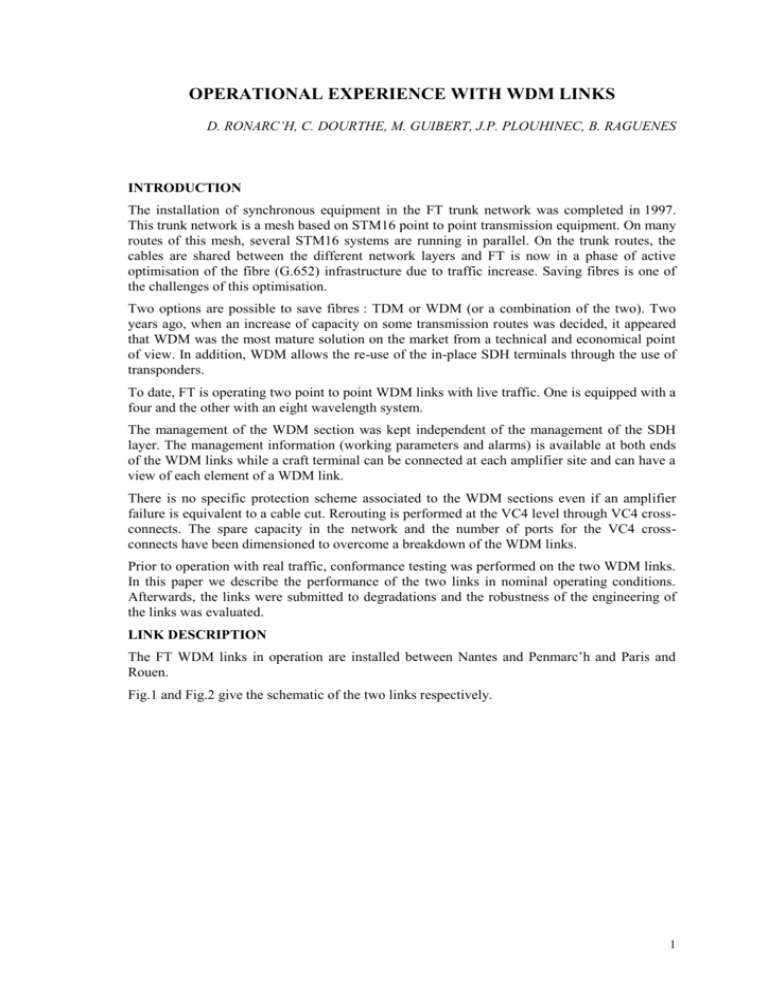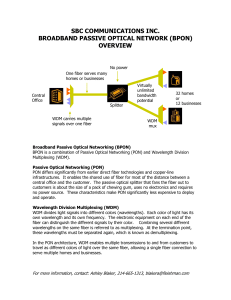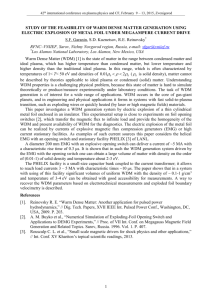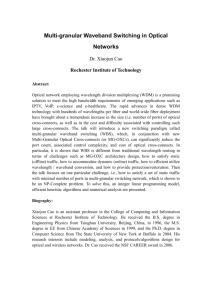Paper02
advertisement

OPERATIONAL EXPERIENCE WITH WDM LINKS D. RONARC’H, C. DOURTHE, M. GUIBERT, J.P. PLOUHINEC, B. RAGUENES INTRODUCTION The installation of synchronous equipment in the FT trunk network was completed in 1997. This trunk network is a mesh based on STM16 point to point transmission equipment. On many routes of this mesh, several STM16 systems are running in parallel. On the trunk routes, the cables are shared between the different network layers and FT is now in a phase of active optimisation of the fibre (G.652) infrastructure due to traffic increase. Saving fibres is one of the challenges of this optimisation. Two options are possible to save fibres : TDM or WDM (or a combination of the two). Two years ago, when an increase of capacity on some transmission routes was decided, it appeared that WDM was the most mature solution on the market from a technical and economical point of view. In addition, WDM allows the re-use of the in-place SDH terminals through the use of transponders. To date, FT is operating two point to point WDM links with live traffic. One is equipped with a four and the other with an eight wavelength system. The management of the WDM section was kept independent of the management of the SDH layer. The management information (working parameters and alarms) is available at both ends of the WDM links while a craft terminal can be connected at each amplifier site and can have a view of each element of a WDM link. There is no specific protection scheme associated to the WDM sections even if an amplifier failure is equivalent to a cable cut. Rerouting is performed at the VC4 level through VC4 crossconnects. The spare capacity in the network and the number of ports for the VC4 crossconnects have been dimensioned to overcome a breakdown of the WDM links. Prior to operation with real traffic, conformance testing was performed on the two WDM links. In this paper we describe the performance of the two links in nominal operating conditions. Afterwards, the links were submitted to degradations and the robustness of the engineering of the links was evaluated. LINK DESCRIPTION The FT WDM links in operation are installed between Nantes and Penmarc’h and Paris and Rouen. Fig.1 and Fig.2 give the schematic of the two links respectively. 1 TxT 1535 nm 26.2dB 26dB 26dB 25.4dB Filter 1543nm 1550nm 1557.5 nm Filter 1535 nm TxT 1543nm 1550nm 1557.5 nm 25.8dB 26dB NANTES 25.6dB 26dB PENMARC'H 323 km Fig.1 : Schematic of Nantes-Penmarc’h Link 1535 nm 27.8dB 27.3dB 1539 nm 1543 nm 1546,2 nm 1550 nm 1553,4 nm 1557,5nm 1560,5 nm 1535 nm 1539 nm 1543 nm 1546,2 nm 1550 nm 27.6dB 27dB 1553,4 nm 1557,5nm 1560,5 nm PARIS 166 km ROUEN Fig.2 : Schematic of Paris-Rouen Link PERFORMANCE IN NOMINAL CONDITIONS - Power levels The optical power levels can be measured in many points of the WDM equipment using the supervisory system. The accuracy of these optical power levels was checked and was found to be within 0.2 dB. 2 Fig.3 gives the optical power levels at different points of the WDM link operating between Paris and Rouen. Two operating conditions are given : 5 and 8 wavelengths in the optical multiplex. Paris Rouen TxT -15.3 +13.3 +13 -17.3 +3.7 -16.3 -18.8 -17.6 -14.3 -4.0 -17.7 -14.3 -21.6 -22.3 -20.6 -21.5 -20.6 -17.8 +13.1 +4.1 +13.7 -3.6 -13.9 +1.0 -4.2 -3.9 -3.7 -3.9 -3.6 -0.6 Levels with 5 wavelengths TxT Levels with 8 wavelengths Optical power in dBm Fig.3 : Optical levels on the Paris-Rouen Link - Bit Error Rate (BER) performance Bit Error Rates were measured as a function of the total preamplifier input power for 4 wavelengths. These measurements give in fact the margin you have for degradation of the last section of the WDM link. Fig.4 shows BER at the SDH receivers of the wavelength 1535, 1543, 1550, 1557 nm while the system is operating eight wavelengths. At 10-10 the worst margin for degradation of the last link section is 11.2 dB for the wavelength 1543 nm. 3 BER 10 -4 (1535) L: 16-2 (1550) L: 16-2 (1543) L: 16-2 Sensitivity at the preamplifier input for BER 10-10 (1557) L: 16-2 10 -6 10 -8 1535 nm 1543 nm -25.2 dBm -25.1 dBm 1550 nm -25.8 dBm 1557 nm -27.7 dBm -10 10 -11 10 -12 10 dBm -35 -30 -25 Fig.4 : BER curves at Paris for the wavelengths 1535, 1543, 1550 and 1557 nm - Optical Spectra The optical spectra can be recorded at the output of each optical amplifier through a monitor output connector. The evolution of the optical signal to noise ratio can therefore be observed along the amplifier chain. What is of interest too is the optical signal available for each SDH receiver. Fig.5 displays on the same graph the spectra at the 8 ports of the demultiplexer unit in Paris. The optical signal to noise ratio in the range of 20-25 dB which is suitable for error free transmission. 4 Site AUBERVILLIERS dBm -15 -20 -25 1535 lnm 1539 nm 1543 nm 1546 nm -30 1550 nm 1553 nm 1557 nm 1560 nm -35 -40 -45 -50 -55 Rés : 0,2nm -60 1530 1534,7 1538,6 1543 1545,7 1549,7 1553,1 1556,5 1559,9 1565 nm Optical Spectra at the de-Mux ports Fig.5 : Optical spectra at the De-Mux ports at Paris terminal 5 ROBUSTNESS OF THE INSTALLED WDM LINKS In optical transmission using electronic repeaters you can define an optical power margin per regeneration section. This margin is a balance between the receiver sensitivity, the laser output power and the section loss. Each regenerator acts like a screen between its input and output transmission section as far as the optical power is concerned. Bit errors are of course transmitted. When optical amplifiers are used, you leave the digital world and analog behaviour is to be considered. In this context, it is not easy to define a margin per amplified section because of noise accumulation along the amplifier chain. If the optical amplifiers are operating in satured conditions, an optical power screening is observed while the signal to noise ratio degrades when the signal level at the amplifier input is lowered. We used the following method to characterise the robustness of the link : We apply an attenuation (degradation) in a section of the WDM link We measure the BER for different wavelengths as a function of the preamplifier total input power. The shift in optical power (in dB) of the BER curves in nominal and in degraded conditions is called degradation penalty. The penalty is measured as a function of the applied degradation. This penalty is in fact the reduction in margin of the last section of the WDM link when a degradation occurs somewhere between the transmitter and the last line amplifier of the chain. The fig.6 and 7 show the penalty at the preamplifier input for a single degradation at point in the Nantes-Penmarc’h link and for a double degradation at points and in the Paris-Rouen link respectively. Points and are the input and output of the booster amplifier respectively. 3.5 For 10 dB attenuation, the total power at preamplier input is not modified 1543 nm 3 1550 nm 2.5 1557.5 nm 2 1.5 1 0.5 0 0 2 4 6 8 10 12 Attenuation at point 2 Fig.6 : Penalty for a single degradation 6 At 9 dB attenuation in and 10 dB in 2 preamplifier , 3 input power is 0.3 dB lower than that of nominal conditions penalty 18 16 14 12 10 8 6 4 2 0 -2 6-8 4-6 2-4 0-2 12 -2-0 9 6 3 attenuation in 3 (dB) attenuation in 2 (dB) Wavelength : 1543 nm Fig.7 : Penalty for a double degradation The measured penalties are far less than the corresponding degradations. The optical amplifiers working in saturated conditions generate an efficient screening of the receiver against line degradation and this is true for all the wavelengths of the optical multiplex. We found this point interesting from an operational point of view. CONCLUSION FT is operating two WDM links with live traffic in the synchronous trunk network. One of them has been working for one year. The strategy of optimising the use of the fibre infrastructure will be continued. The robustness of the installed links is satisfactory with regard to additional attenuation or amplifier degradation performance. The availability of a meshed WDM network is an issue in case of amplifier breakdown. Rerouting at the VC4 level through SDH cross-connects is a solution for today. Redundancy in the optical amplifiers would improve the availability of the meshed network. The association of WDM and SDH ring architecture is efficient from a protection point of view. 7








